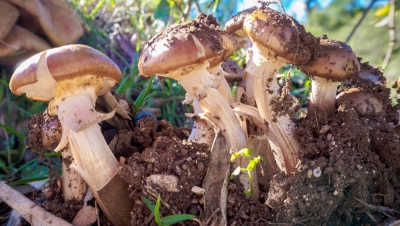Neither plant nor animal, mushrooms have confounded humans since ancient times. Now, they’re a reminder of our tenuous place in an uncertain world.
The mushrooms sit on high, behind glass, above bottles of Armagnac and mezcal in a bar at the Standard hotel in Manhattan’s East Village. They are barely recognizable at first, just eerie silhouettes resembling coral growths in an aquarium, blooming in laboratory-teal light: tightly branched clusters of oyster mushrooms in hot pink, yolk yellow and bruise blue, alongside lion’s mane mushrooms, shaggy white globes with spines like trailing hair.
This isn’t décor, or only incidentally so; the 15-foot-long shelf is a miniature farm, installed by the New York-based start-up Smallhold as part of a larger, sprawling system made up of remote-controlled nodes at restaurants and grocery stores across the city, each producing from 30 to 100 pounds of mushrooms a week. Thousands of data points — on temperature, humidity, airflow — are transmitted daily to the company’s headquarters, to be recalibrated across the network as needed. At the Standard, where the crop goes into plates of chilaquiles and mushroom-infused bourbon cocktails, diners might stop midbite, look up and take note of their meal’s origins a few feet away. It’s a glimpse of the future of agriculture, further collapsing the distance between diner and ingredients, doing away with the cost and waste of packaging and transportation in hopes of alleviating pressure on an overtaxed environment.
Read the full article here.
Source: New York Times By






















